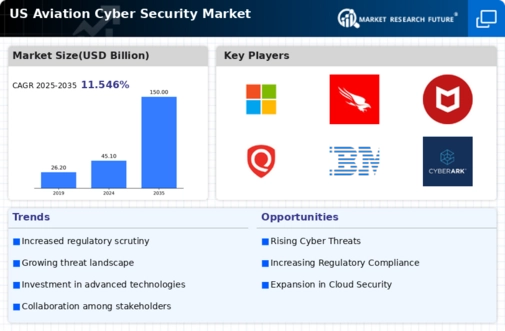The US Aviation Cyber Security Market is characterized by a robust and evolving landscape that is responding to the increasing frequency and sophistication of cyber threats. As enterprises and organizations across various sectors prioritize their digital security, numerous players have emerged, each specializing in diverse cybersecurity solutions ranging from network security and threat intelligence to cloud security and endpoint protection. This competition is fueled not only by the need for compliance with regulatory requirements but also by the demand for proactive risk management strategies.
The market dynamics reflect a blend of established tech giants and agile startups, each vying for a significant share while addressing shifting customer needs and technological advancements. Furthermore, partnerships, mergers, and collaborations within the sector are common as companies seek to enhance their capabilities and extend their service offerings.In the US Aviation Cyber Security Market, Microsoft has established itself as a formidable leader by leveraging its extensive portfolio and cross-industry presence. The company’s strengths lie in its integrated security solutions that aim to provide comprehensive protection across cloud services, applications, and devices.
Microsoft’s security software, such as Microsoft Defender, has gained significant traction due to its advanced threat detection and response functionalities. Additionally, Microsoft's commitment to continuous innovation ensures that its cybersecurity offerings are aligned with the latest technological trends and user demands.
With a strong reputation and a diverse customer base across both public and private sectors in the United States, Microsoft effectively capitalizes on its existing client relationships to drive further adoption of its security products, reinforcing its competitive standing in the cybersecurity space.CrowdStrike has emerged as a key player in the US Aviation Cyber Security Market, particularly renowned for its cloud-native endpoint protection platform that employs artificial intelligence to address complex security challenges.
The company offers a range of services such as incident response, threat intelligence, and managed security services which cater directly to the needs of organizations facing sophisticated cyber threats. CrowdStrike's strengths lie in its innovative technology and the ability to deliver real-time monitoring and proactive threat hunting, which significantly enhances the security postures of its clients. Additionally, CrowdStrike has pursued strategic mergers and acquisitions to bolster its capabilities and expand its market footprint, thereby solidifying its competitive advantage.
The company has successfully positioned itself as a trusted partner for numerous enterprises in the US, providing them with essential tools and insights to safeguard their digital assets against escalating cyber risks.


























Leave a Comment